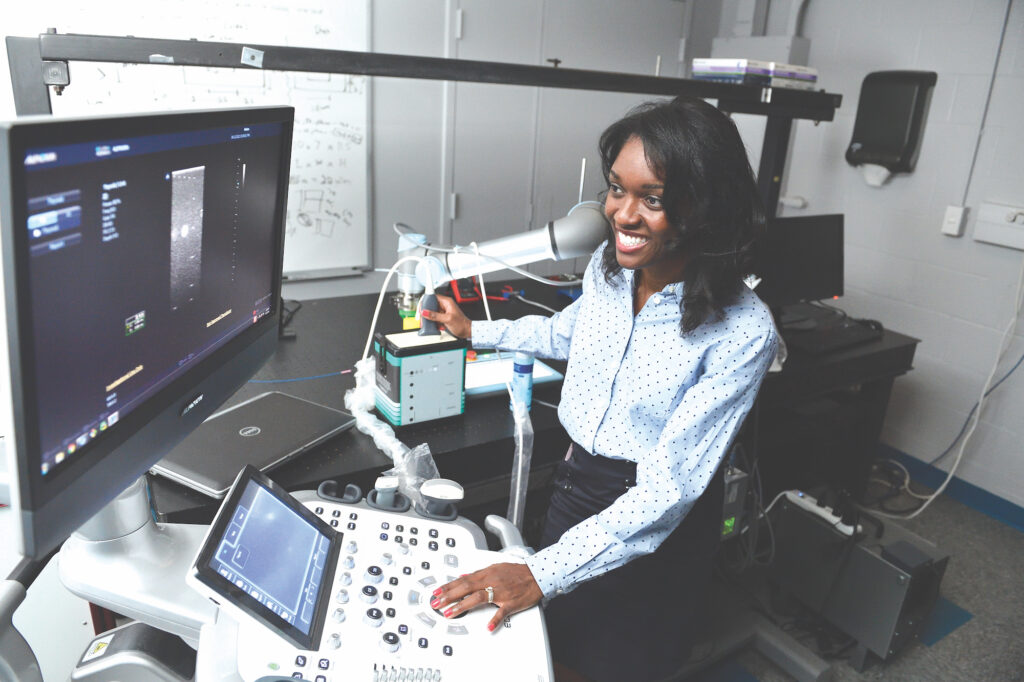
Insufficient federal funding for research by Black scientists is a key factor in preventing equitable contributions to science and achievement of these scientists’ full potential, according to the Whiting School’s Muyinatu Bell, the John C. Malone Assistant Professor of Electrical and Computer Engineering, who was among co-authors from 15 institutions whose commentary appeared in Cell in January.
“I pay taxes,” says Bell. “My colleagues, friends, and family members who are all supportive of equity principles pay taxes. Yet there is a documented 20-year history of inequitable distribution of these tax dollars to Black researchers for biomedical research. This is a major problem that must be addressed.”
In their commentary, Bell and her co-authors cite several studies of funding allocation by the National Institutes of Health to Black scientists over the past decade, which reveal that Black applicant award rates are about 55% that of white principal investigators of similar academic achievement. The authors contend that this funding gap has continued despite internal reviews of the reasons for the disparity and promises by NIH to do better.
The scientists point out that while efforts have been made to encourage Black students to enter careers as researchers and college and university faculty, once appointed, lack of research funding can stifle and even ruin their careers, especially as their ability to garner NIH and other funding plays into tenure and promotion decision-making.
“Differences in lab size, perceived research importance, and access to opportunities that require major NIH research funding are some of the consequences of the current disparity. Ultimately, these differences derail careers in a way that is not tied to aptitude nor fundamental potential for success,” says Bell.
These disparities, Bell continues, can have far-reaching effects on future generations of scientists. “It’s very important for young students to have role models in the sciences who come from the same racial background,” she says. “These role models are effective with regard to changing perceptions about who is or who can be a scientist, not only for Black students but also for anyone watching the world around us.”
She and her co-authors make several recommendations on how research funding disparities can be eliminated. Among the steps they recommend funding agencies take are:
- Explicitly state that racism persists in the U.S. research enterprise and that it must be expelled.
- Develop federal funding institute policies to immediately achieve racial funding equity.
- Incorporate diversity into research proposal scoring criteria, prioritize research teams that exemplify diversity, and diversify proposal review panel.
- Train funding agency leadership and staff, as well as grant reviewers and recipients, to recognize and stop racism.
Bell hopes that NIH will respond to the commentary by publicly acknowledging that there is a problem and by “implementing our suggestions to eliminate it, particularly with regard to insidious, double-standard comments at the grant review stage.”
The paper also urges individual scientists and universities to move beyond statements of solidarity to make meaningful and transformative organizational changes, and calls on those in the private sector—such as philanthropists and industrial leaders whose companies depend on scientific innovation, as well as on foundations and professional societies—to help offset racial disparities in research funding. Funding the innovative ideas and robust talents of Black scientists, the authors say, will benefit all of society.
“We all have the power to change this,” says Bell. “In doing so, it will help the entire biomedical research enterprise, as greater diversity in research at all levels has consistently translated to the delivery of more innovative science and technology.”




